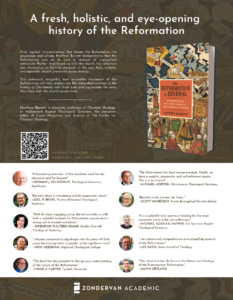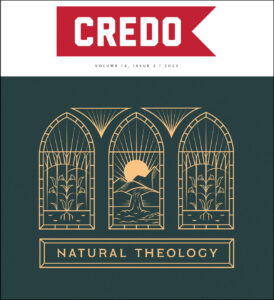 The question of God’s existence has been a subject of profound contemplation throughout human history. In this area, the demonstrations put forth by Thomas Aquinas (1225–74) stand as a formidable framework for exploring this subject, and their profound impact on the theology and culture of Christian churches cannot be overstated. Although his arguments were not formulated in the context of an atheistic culture as seen in modernity, examining Aquinas’s arguments today—especially his elaborations of the principles of causation and contingency—still holds immense value in conceptualizing God’s existence in philosophical ways. This is true even for a Protestant, as his ideas belong to the broader Western theological tradition, of which Protestantism is a part.
The question of God’s existence has been a subject of profound contemplation throughout human history. In this area, the demonstrations put forth by Thomas Aquinas (1225–74) stand as a formidable framework for exploring this subject, and their profound impact on the theology and culture of Christian churches cannot be overstated. Although his arguments were not formulated in the context of an atheistic culture as seen in modernity, examining Aquinas’s arguments today—especially his elaborations of the principles of causation and contingency—still holds immense value in conceptualizing God’s existence in philosophical ways. This is true even for a Protestant, as his ideas belong to the broader Western theological tradition, of which Protestantism is a part.
Preliminary 1: Defending God’s Existence
A vibrant tradition existed within the Reformed world that adopted and appropriated a scholastic understanding of God's existence. Click To Tweet Before delving straight into his Five Ways in the Summa Theologica, Aquinas first addressed objections that challenged the affirmation of God’s existence. One significant objection centers around the problem of evil. Those who raise this objection argue that, if God is infinitely good, there should be no existence of evil in the world. However, evil does exist, posing an apparent contradiction to the existence of God. Consequently, it should be concluded that God does not and cannot exist. Another objection posits that everything in the world can be adequately explained by simpler principles, such as natural laws for natural phenomena or human reason and will for voluntary actions. According to this view, the existence of God becomes “superfluous,” and appeals to natural phenomena should suffice for understanding and explaining the world, rendering the need for God’s existence unnecessary. In response to these objections, then, Aquinas presents sophisticated demonstrations using the principles of logic and metaphysics, famously known as the Five Ways, to counter these arguments and establish a conceptual foundation for the existence of God.
Preliminary 2: Demonstrating God’s Existence
As another preliminary, it is worthwhile to point out that Aquinas presents two distinct methods of demonstration closely connected to his overall approach. The first method, known as “a priori,” involves reasoning from the cause to its effect, for by comprehending the cause of a phenomenon, we can delve deeper into the nature and purpose of its effects. Consider a simple wooden chair, for example. When we closely examine the chair, paying attention to its structure, design, and functionality, we come to realize that it has been skillfully crafted by a carpenter. Through the analysis of the chair’s cause—the intentions, skills, and efforts of the carpenter—we then gain a profound understanding of the chair itself, as its structure of existence is better illumined by its cause, and as its purpose is tethered to the intention of the maker.
The second method, known as “a posteriori,” takes a different approach. It reasons from effects to their cause, emphasizing understanding the cause itself. Imagine now a lush garden brimming with vibrant flowers. Applying this “a posteriori” method, we can reason from the effects—the captivating beauty of the flowers—to gain insights into their cause. As we closely observe the flowers’ vivid colors, intricate patterns, and delightful fragrances, we naturally infer the presence of a skilled gardener who cultivates and nurtures the garden. By studying the effects, then, we acquire knowledge not only about the existence of the gardener but also something about their diligence, habits, and even the tools employed. This approach allows us to comprehend the cause by closely examining its effects, and while it differs from the first method, it still demands a comprehensive consideration of both causes and effects as a whole, as their intricate relationships form the order of motion that human reason attempts to grasp in making sense of the structure of the world.
First Way: Demonstrating God’s Existence from Motion
In light of such methods of demonstration, Aquinas goes on to argue from the nature of motion in his First Way. Aquinas notes that, in this world, we can observe objects in motion and recognize that anything that is moved is set in motion by something else. An object can only move if it possesses the potential to transition from one state to another, or, to put it differently, motion is the actualization of a potency that undergoes change. Aquinas provides an illustration to support this idea, explaining how fire, which is actually hot, can transform a potentially hot wood into an actually hot wood through their interaction. The fire’s action on the wood initiates the change, causing it to move and undergo a transformation, and the wood receives and responds to the act, resulting in its nature being heated up. Hence Aquinas writes: “Now whatever is in motion is put in motion by another, for nothing can be in motion except it is in potentiality to that towards which it is in motion; whereas a thing moves inasmuch as it is in act. For motion is nothing else than the reduction of something from potentiality to actuality. But nothing can be reduced from potentiality to actuality, except by something in a state of actuality.”[1]
Aquinas emphasizes that there must already exist something in an actual state to bring about a change in a thing that is merely potential. Click To Tweet One important question arises here: why can’t we continue an infinite regress of movers within creation, but should arrive at the first mover? Do we really need to arrive at one singular mover as the starting point of all movements? Though this is a popular objection to the First Way, we should remember the fact that motion, as expressed in Aquinas’s thought, refers to the actualization of potentiality. Aquinas emphasizes that there must already exist something in an actual state to bring about a change in a thing that is merely potential. Thus Aquinas contends that if an infinite process of motion were to occur without an ultimate source of actuality, potentiality would remain perpetually unrealized, rendering motion itself impossible. In this sense, what Aquinas was really arguing was that “everything that undergoes change is moved by another,” rather than “everything is moved by another.” The first claim is confined to the created realm, as God is excluded from this claim as the unchanged mover, while the latter can technically include God, if the term “everything” includes anything that exists with the fullness of life. So it is crucial to understand the nature of motion and how it relates to God, as Aquinas unfolds the rest of his arguments in the light of such a concept of motion.
Second Way: Demonstrating God’s Existence from Causation
Expanding upon his understanding of motion, then, Aquinas proceeds to introduce the Second Way of demonstrating God’s existence, delving further into the nature of efficient causes. An efficient cause, in essence, is that which brings about or produces an effect. What is important to grasp in this concept is that no entity can be its own efficient cause, for such a circumstance would necessitate its existence prior to itself, which is a logical impossibility. For instance, for a dog named Max to bring himself into existence, he would need to exist before his own existence, otherwise the subject that performs the act of creation would be missing in the order of motion. If this is the case, then, the act of bringing himself to existence becomes totally redundant, as he already exists as one capable of living and behaving. This will be an obvious contradiction to the concept previously explained, and Aquinas made repeated arguments to emphasize this point. No entity can be its own efficient cause, for such a circumstance would necessitate its existence prior to itself, which is a logical impossibility. Click To Tweet
So, if an existent cannot be its efficient cause in the realm of motion, then what actualizes things in the first place? What is that very thing that began the whole order of moving and actualizing in the world of creation? The answer can be gathered from his theory of motion, because a thing that is already actualized can move a thing in potency. An efficient cause therefore should be external to the thing itself in the order of motion and, in that sense, Aquinas asserts that there must exist a first efficient cause—a prime mover—that initiates the chain of causality for all things in creation. This prime mover is the ultimate source from which all other efficient causes derive their ability to cause change, and unless they are moved by this ultimate cause, they would have no power to change another. Hence Aquinas’s Second Way of demonstrating God’s existence adds depth and support to his overall argument for the existence of God, and it is a more specific treatment of the broader issue of motion by focusing specifically on the efficient cause of all things and relating it all to God.
Third Way: Demonstrating God’s Existence from Contingency
Aquinas’s Third Way of demonstrating God’s existence builds upon the concepts of possibility and necessity. He observes that, in nature, things possess the possibility of existing or not existing. It was possible that you would not come to exist had your parents not met decades ago, and it was possible that your favorite car would not be parked in your garage had you not had the money to buy it. At the same time, if everything were merely possible and nothing necessary, then we cannot make sense of the order of motion and causation as explained above—why did one actualize the other, when it was not necessary? How do we make sense of one thing being actualized while the other remains unmoved?
In relation to that, Aquinas proposes that there must exist a necessary being—a being whose existence is not contingent upon anything else and whose life is not merely possible. This necessary being, which he identifies as God, possesses the fullness of existence in and of Himself, without any dependency on external factors or causes. It is the source and foundation of all possibilities, the ultimate explanation for why contingent beings come into existence, and it is the highest reason in the order of power (not just first in the order of origin) that moved certain things to become actualized, even while others remain unactualized or unrealized.
In summary, then, Aquinas’s demonstrations of God’s existence operate within the broader theory of motion that considers two crucial metaphysical terms: potency and actuality. The Second Way, focusing on efficient causes within the flow of motion, establishes the need for a prime mover as the ultimate source of actuality, while the Third Way emphasizes the existence of a necessary being to explain the rationale behind all actualities. Together, these demonstrations bolster Aquinas’s case for the existence of God as the transcendent cause and actualizer of the universe, and they shed light on the intricate relationships between causes, effects, possibility, and necessity that function as the building blocks of human intelligence, and as the rational demonstrations of God’s existence.
Reformed Scholastic Demonstrations of God’s Existence
Before we conclude, it will be worthwhile to speak briefly on the dynamic engagement of Reformed scholastics with the patterns of thought explained above. As an example of this, Francis Turretin (1623–87) articulates a persuasive argument for God’s existence, rooted in the principle of causality and the implausibility of an infinite chain of causes. Turretin propounded the necessity of an orderly sequence of causes, ruling out the notion of an infinite series, as it would demand an impossible preponderance of causes before any given cause. Instead, he argued for the inevitability of a prime cause, superior to all, marking the culmination of the causal series—the cause which he identified as God. Similarly, William Ames (1576–1633) and Wilhelmus à Brakel (1635–1711) expanded on this theme. Ames maintained that God’s essence inherently posits Him as the prime being, existing independently of external influences: “The essence of God is that by which he is absolutely the first being… God exists of himself, that is to say, not from another or of another or by another or by reason of another.”[2] Following suit, à Brakel outlined a compelling vision of God as eternal, transcendent, and the original cause of all things, and thus made this claim: “All change occurs either because the principle of change is inherent in us, or because our nature is such that someone else is capable of bringing about a change in us. God, however, is eternal, transcendent, and the original cause of all things.”[3]
“The essence of God is that by which he is absolutely the first being… God exists of himself, that is to say, not from another or of another or by another or by reason of another.” Click To Tweet It should be evident that the Reformed scholastic engagement with these concepts did not focus on the number of ways by which one can demonstrate God’s existence, but on the motional, causal, and ontological conditions that reason can grasp about the world through rigorous use of logic. Their defense of God’s existence also appeals to “conscience”— beyond “causation” and “contingency”—and it is apparent in the works of Turretin and also Petrus Van Mastricht (1630–1706), for example. This illustrates that the appeal to conscience in the discourse on the knowledge of God does not invalidate other lines of reasoning, and, similarly, arguments hinged on causation and contingency should not undermine the importance of conscience as the actual seat of human knowledge of God. These various approaches coexisted in the thought of Reformed theologians, offering a rich, multifaceted perspective on theological inquiry, and we are confronted with this expansive view concerning how to demonstrate God’s existence as we read their works and reflect on them.
A vibrant tradition
Thus, a vibrant tradition existed within the Reformed world that adopted and appropriated a scholastic understanding of God’s existence. This tradition affirms the continuing value of delving deeper into Aquinas’s ideas to explore the subtleties of this intellectual stream. At the same time, it is worth noting that Reformed thinkers did not perceive themselves as direct successors of the Dominican or Roman Catholic traditions. Rather, they engaged with Aquinas’s ideas with a balanced mindset, and selectively used them for their unique contexts. They managed to retain the classic ideas while concurrently reforming the system of theology, and it is high time that we do the same in our own contexts.
Endnotes
[1] Thomas Aquinas, ST, Iª q. 2 a. 3 co. 2.
[2] William Ames, The Marrow of Theology, 84.
[3] Wilhelmus à Brakel, The Christian’s Reasonable Service, I.100.


